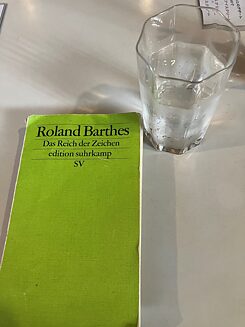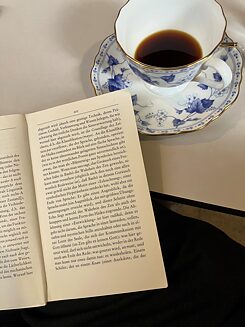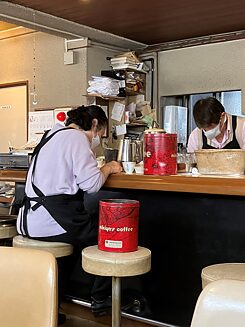Word! The Language Column
Haibun, or How I Learnt to Limp from Book Learning about Japan

Our new columnist Jan Snela thinks back on his trip to Japan a few months ago, interweaving recollections with reflections on the books he lugged around – or didn’t.
By Jan Snela
It’s been three months since my trip to Japan and I’m wondering: Which books did I bring along? I’ve been rummaging around for clues between a duty-free bottle of sake and a couple packets of those truly Irresistible Rice Crackers & Peanuts you can get at any Combini (late-night convenience shops in Japan); between a notebook page on which Kimie, my bed-and-breakfast hostess in Kamakura, jotted down a haiku by Matsuo Bashō in kanji (Japanese characters) as well as in a phonetic transcription and in English translation, and four iron balls I nicked from the Pachinko Parlour in Nara, not to mention dozens of receipts – no idea now why I held on to them. All in vain. I can’t find even a fragment of a quote on any of the various slips of paper I actually did scribble on.
Enough ballast for a backache
 Japan Travel Reading: Roland Barthes’ “In the Realm of Signs”
| photo: Jan Snela
But of course: Roland Barthes’ Empire of Signs, my favourite Japan fetish, with its spellbound stylization of Japanese phenomena into the ultimate other with respect to the European tradition. And, of course, Matsuo Bashō’s The Narrow Road to the Deep North, a collection of haibuns, i.e. short prose pieces by a classical haiku poet. What else? I’m sure I didn’t have any of that basic intro-to-Japanese-culture stuff like Karl Löwith’s The Japanese Mind or Ruth Benedict’s The Chrysanthemum and the Sword: Patterns of Japanese Culture. More likely Christoph Peters’ Days in Tokyo and Kenzaburō Ōe’s The Changeling. In any case, it wasn’t that many books by my standards. Still, enough ballast to hurt my back during my real-life slogs from the local train to the shinkansen “bullet train”, from the Great Buddha of Kamakura to the doors of the Mist club in the nightclub district of Kochi-shi, which remained closed to me.
Japan Travel Reading: Roland Barthes’ “In the Realm of Signs”
| photo: Jan Snela
But of course: Roland Barthes’ Empire of Signs, my favourite Japan fetish, with its spellbound stylization of Japanese phenomena into the ultimate other with respect to the European tradition. And, of course, Matsuo Bashō’s The Narrow Road to the Deep North, a collection of haibuns, i.e. short prose pieces by a classical haiku poet. What else? I’m sure I didn’t have any of that basic intro-to-Japanese-culture stuff like Karl Löwith’s The Japanese Mind or Ruth Benedict’s The Chrysanthemum and the Sword: Patterns of Japanese Culture. More likely Christoph Peters’ Days in Tokyo and Kenzaburō Ōe’s The Changeling. In any case, it wasn’t that many books by my standards. Still, enough ballast to hurt my back during my real-life slogs from the local train to the shinkansen “bullet train”, from the Great Buddha of Kamakura to the doors of the Mist club in the nightclub district of Kochi-shi, which remained closed to me. Out of 833 hours, only two were spent reading
| photo: Jan Snela
From my arrival at Narita Airport near Tokyo to my departure, I spent a total of 833 hours in Japan. I spent all of two hours there reading – at least in the sense of leafing through a book, putting letters together to form words, and words to form sentences, on the printing plate of my brain. I spent all my other waking hours there marvelling at the signs of life of a culture I knew previously by and large only from reading about it, vital signs that belied the deadening letters. And vaguely calligraphing things both astounding and actual, things both manifest to me and elusive, things that can hardly be subsumed under the term “culture”.
Out of 833 hours, only two were spent reading
| photo: Jan Snela
From my arrival at Narita Airport near Tokyo to my departure, I spent a total of 833 hours in Japan. I spent all of two hours there reading – at least in the sense of leafing through a book, putting letters together to form words, and words to form sentences, on the printing plate of my brain. I spent all my other waking hours there marvelling at the signs of life of a culture I knew previously by and large only from reading about it, vital signs that belied the deadening letters. And vaguely calligraphing things both astounding and actual, things both manifest to me and elusive, things that can hardly be subsumed under the term “culture”.
An old couple
 The two of them looked like they were continually bowing to each other
| photo: Jan Snela
Two hours spent reading. At a café on the first floor of a little building in Kyoto, run by an old couple like Philemon and Baucis, improbable in their wordless intimacy: at some point in the past – perhaps decades ago – they must have made up their minds to spend the rest of their born days together sorting, roasting and grinding coffee beans and brewing coffee. Stooping over their respective tasks, the two of them looked like they were continually bowing to each other. I marvelled at the degree of their nestedness, at this silence. A Japanese film was playing inside me:
The two of them looked like they were continually bowing to each other
| photo: Jan Snela
Two hours spent reading. At a café on the first floor of a little building in Kyoto, run by an old couple like Philemon and Baucis, improbable in their wordless intimacy: at some point in the past – perhaps decades ago – they must have made up their minds to spend the rest of their born days together sorting, roasting and grinding coffee beans and brewing coffee. Stooping over their respective tasks, the two of them looked like they were continually bowing to each other. I marvelled at the degree of their nestedness, at this silence. A Japanese film was playing inside me:How the two of them would wait till evening to talk, animatedly and yet with restraint, about the strangers who’d come into their establishment that day = one of those dialogical meditations to be found in Ōe, chance signs as meaningful clues. Though driven by the exact opposite of the European yen to solve the mystery or riddle sooner or later.
Barthes, Philemon and Baucis
Two hours in the Empire of Signs. With a backache. And a classical music station playing at the bottom of my aural consciousness. Was this still the Western inner radiophony that keeps the uninterrupted conversation with one’s self going, or was I already hearing the echoless cut = the “end of discourse”? In any case, Fi-le-mon and Bao-tsi remained silent for the duration of my stay there.Incidentally, I was in Japan to do some research for a book. More precisely: for a haibun. I’d like to tell you about it right here, right now, but it’ll have to wait till next time. Many years ago, a Japanese woman I met at a garden party told me that the Japanese don’t like articulating more than 60 per cent of a thing. Besides, I’m already well over the roughly 3500-character limit for this column.
Word! The Language Column
Our column “Word!” appears every two weeks. It is dedicated to language – as a cultural and social phenomenon. How does language develop, what attitude do authors have towards “their” language, how does language shape a society? – Changing columnists – people with a professional or other connection to language – follow their personal topics for six consecutive issues.